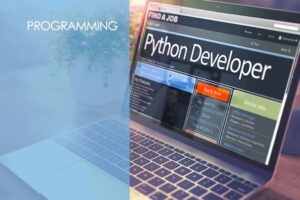Course Overview

Course objectives
Created nearly 30 years ago, it is now one of the most popular languages out there to use. Its popularity is particularly important in the data science and machine learning fields. But it is also a language that is easy to learn, and that is why it has become the language most taught in universities. Python interpreters are available for the main operating systems as well (Linux, Mac OS, Windows, Android, iOS, BSD, etc.) so it’s very flexible in where it is used.
Modules
Module 1: Getting Started with Python
- Module 1 File
- Intro to Course and Instructor
- Getting Started with Python
Module 2: Working with Primitive Data Types
- Module 2 File
- Working with Primitive Data Types
- Working with Primitive Data Types Part 2
- Working with Primitive Data Types Part 3
- Working with Primitive Data Types Part4
- Working with Primitive Data Types Part4 Answers
Module 3: Working with Multiple Assignments Statements
- Module 3 File
- Working with Multiple Assignments Statements
Module 4: Convert Types in Python
- Module 4 File
- Convert Types in Python
Module 5: Creating Lists
- Module 5 File
- Creating Lists
Module 6: Modifying Lists
- Module 6 Notes
- Modifying Lists
Module 7: Sorting and Reversing Lists
- Module 7 File
- Sorting and Reversing Lists
Module 8:Slicing Lists
- Module 8 File
- Slicing Lists
Module 9: Working With Operators
- Module 9 File
- Working With Operators
- Working With Operators Part2
- Working With Operators Part3
Module 10: Determining Operator Precedence
- Module 10 File
- Determining Operator Precedence
Module 11: Working with IF Statements
- Module 11 File
- Working with IF Statements
Module 12: Working With For Loops
- Module 12 File
- Working With For Loops
Module 13: Working With While Loops
- Module 13 File
- Working With While Loops
Module 14: Nesting for Loops
- Module 14 File
- Nesting for Loops
Module 15: Reading Files
- Module 15 File
- Reading Files Part1
- Reading Files Part2
Module 16: More on Files
- Module 16 File
- More on Files
Module 17: Merging Emails
- Module 17 File
- Merging Emails
Module 18: Reading Console Inputs and Formatting Outputs
- Module 18 File
- Reading Console Inputs and Formatting Outputs
Module 19: Reading Command Line Argument
- Module 19 File
- Reading Command Line Argument
Module 20: Defining Functions
- Module 20 File
- Defining Functions
Module 21: Using Default Argument
- Module 21 File
- Using Default Argument
Module 22: Using Keyword and Positional Arguments
- Module 22 File
- Using Keyword and Positional Arguments
Module 23: Handling Exceptions
- Module 23 File
- Handling Exceptions
Module 24: Using Math and Random Modules
- Module 24 File
- Using Math and Random Modules
Module 25: Displaying Daytime Working Directory and File Metadata
- Module 25 File
- Displaying Daytime Working Directory and File Metadata
Modes of Learning
- Flashcards: Remember the “read and guess” games we used to play back then? Here’s to enhance what you learned. How does it work? A statement will be written on a flashcard, and you’ll need to guess the answer. Then flip it over to see if you answered it correctly. The cards continue, each with a random statement from the course that you took previously.
- Scatter: “Make Everything Disappear.” Turn the screen white and vanish it all but this time testing your knowledge and your time being monitored. Find the best match and click your way toward success. This brain teaser might give you a hard time! But education combined with games adds an element of fun to it.
- Learn: Here’s another. Read and choose the right answer. A game designed on a Multiple-Choice pattern. This kind of exercise boosts your confidence. When one option seems to be correct, you choose the other only for it to be the right option. The right option will welcome another statement, but don’t sweat! You are still learning.
- Speller: This fun-packed game is unique in its own way. Hear the term carefully and type it out on your screen. You think you are a pro at learning spellings of tricky terms. Test yourself out with this game. Could you hear it properly? If you could, were you able to write it?
We have found our students doing absolutely great by showcasing their certificates. Grab that certificate of yours before someone else does and get that recognition you deserve.
You best learn when you see it. Our easy-to-understand video content is in place for you. Watch the studying content and grasp all the concepts easily. With so many lectures and 3000+ hours of video content, find what suits your needs. These educational videos are designed to sharpen your experience with your training content. Our easy-to-understand video content is in place for you. Watch the studying content and grasp all the concepts easily.
In contrast to other e-learning services, our labs will let you exercise what you analyze in a real environment with a lot to choose from. This layout mirrors the traditional study room format which ensures you will recognize exactly the way to set up, manage and troubleshoot any environment.
Being a successful IT professional involves more than knowing key terms and concepts. You need to be able to “apply” your knowledge to real-world situations. At EZDA we quote, “Learn it to pertain to it.” So, why spend money buying the equipment when we got you all covered?
